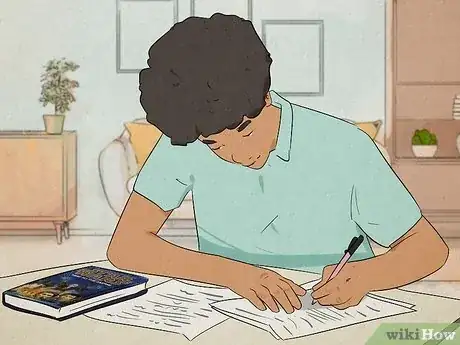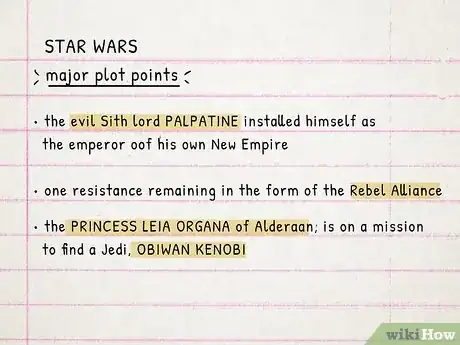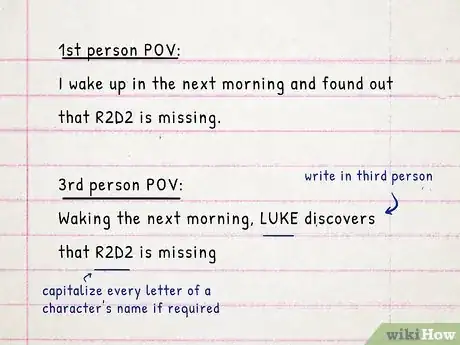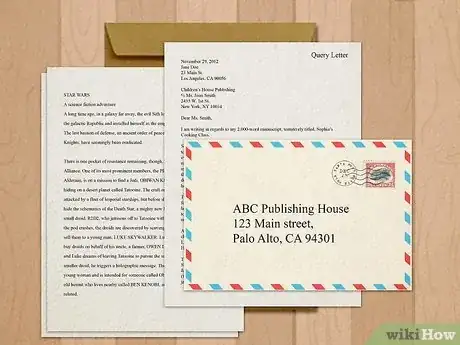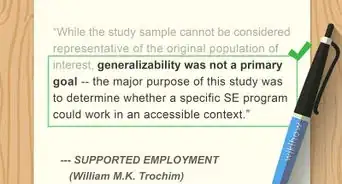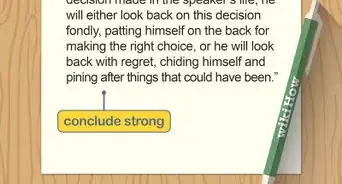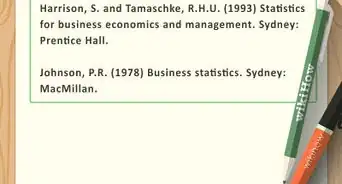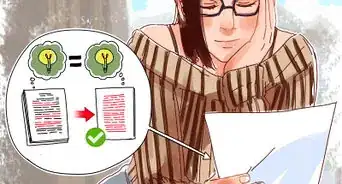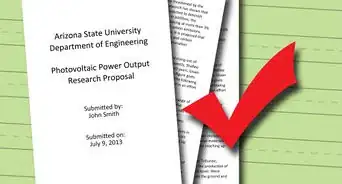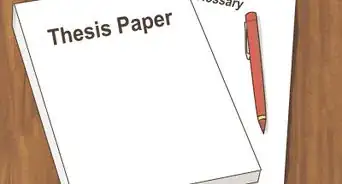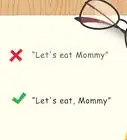This article was co-authored by Richard Perkins. Richard Perkins is a Writing Coach, Academic English Coordinator, and the Founder of PLC Learning Center. With over 24 years of education experience, he gives teachers tools to teach writing to students and works with elementary to university level students to become proficient, confident writers. Richard is a fellow at the National Writing Project. As a teacher leader and consultant at California State University Long Beach's Global Education Project, Mr. Perkins creates and presents teacher workshops that integrate the U.N.'s 17 Sustainable Development Goals in the K-12 curriculum. He holds a BA in Communications and TV from The University of Southern California and an MEd from California State University Dominguez Hills.
There are 12 references cited in this article, which can be found at the bottom of the page.
wikiHow marks an article as reader-approved once it receives enough positive feedback. This article has 12 testimonials from our readers, earning it our reader-approved status.
This article has been viewed 333,359 times.
A synopsis is an in-depth summary of a written work that describes the content of that work from beginning to end. Unlike a summary, which just gives a general overview of a story, a synopsis contains all of the plot details, including the end. Typically, synopses are submitted to publishers or agents after you have written a novel, screenplay, or other long work. A good synopsis will cover the main conflict and the resolution of the story while describing the emotional development of the main character. It is important to edit your synopsis carefully, as it will usually be included as part of a larger proposal.
Steps
Outlining Your Synopsis
-
1Start the synopsis after you have finished the project. In most cases, agents and publishers will only be interested in completed manuscripts. Writing your synopsis after you finish the manuscript will help you identify the main characters, plot points, and conflict.[1]
- Established authors who have published before may be able to get away with submitting an incomplete book proposal, but most new authors will need a full manuscript.
- You will need to know how the story ends to write the synopsis, as a synopsis will include the resolution of the story.
- Re-read the first sentence of every chapter or scene to refresh your memory on the plot points.[2]
-
2Make a list of your main characters. This may include the protagonist, a love interest, a villain, or a sidekick. Only the most important characters should be mentioned in a synopsis. Take a minute to write out who your main characters are.[3]
- Make sure each of your characters is dynamic, rather than flat. They all need to be well-rounded and capable of change. Additionally, each character should impact the story in a significant way.
Advertisement -
3Sketch out the major plot points in your story. The synopsis will cover the main narrative arc of your story. This arc usually does not include subplots, unless the subplot is important to the overall conclusion of the main arc. Try to outline the main conflict, rising action, and conclusion of your story.[4] [5]
- If you wrote a novel or memoir, you may want to write down a one sentence summary of each chapter. For example, you might write, “Rory looks for his father and meets an old friend.”[6]
- If you wrote a screenplay or play, make a list of what happens in each act. You can write, "Rory enters the warehouse, and a shootout ensues."
- If you have a collection of short stories or poetry, identify the main themes of each work. For example, you might state, "This collection explores memory, childhood, and innocence."
-
4Identify what is unique about your story. Publishers and agents read hundreds of synopses a week. To make yours stand out, highlight what is unique in your own story. Use this angle to make your synopsis different or interesting.[7]
- Does your story have an interesting point of view? If so, be sure to mention it. You can say, “This story centers around the last dwarf in the underground kingdom.”
- Does your story have a unique twist? You can mention the twist while still leaving some mystery. For example, you might say, “Jean Paul soon realizes that the murderer may be closer to him than he thinks.”
- Does your story fulfill a certain niche in the market? You might want to demonstrate who might be interested in this story. For example, you can write, “This memoir explores what it means to be a member of the lost generation.”
-
5Research how long the synopsis must be. Every publishing house and agent will have different requirements for synopsis length. Before writing your synopsis, look up a few publishing houses, film production companies, or agents. They should list their requirements on their website.[8]
- Novel synopses are usually between two and twelve pages long.
- Screenplay synopses are usually one page long. Most are no more than 400 words long.
Drafting the Synopsis
-
1Write in third person. Even if you are writing a memoir or a book in first-person, always write the synopsis in third person, using "he," "she," "it," and "they" as pronouns. Throughout the synopsis, restate the main characters' names frequently.[9]
- Most film production companies and some book publishers may ask you to capitalize every letter of a character's name. For example, you would write "JENNA" instead of "Jenna."
-
2Introduce your main characters and conflict at the beginning. The first paragraph should introduce all of the main characters while giving a general summary of the entire plot. The first paragraph should hook your readers without being too specific.[10]
- For example, you might start the paragraph by saying, “When her plane crashes in the isolated reaches of the Amazon rainforest, Laura realizes that to survive, she must first overcome her inner demons.”
- As you introduce other characters, you should introduce them in relation to the main character. For example, you might write, “Laura is joined by the only other survivor, a mysterious archaeologist named Terry.”
-
3Summarize the main events of the plot. Include any obstacles that the character faces and describe how they overcome these obstacles. Avoid subplots and any backstories in your synopsis unless they are crucial to understanding the main plot.[11]
- Don't go into too much detail about subplots and minor actions. You don't want your synopsis to be confusing, so focus on the main story line.
- For example, you might write, "After James beats the river monster, he continues on to find the magic crystal. When he locates the cave, he finds it blocked. He agrees to trade his sword to a goblin in exchange for help."
-
4End with resolution of the book. Your reader should understand exactly how the plot resolves. This is not a good time to introduce any new information about the book. It is never a good idea to leave out the ending in a synopsis. A publisher or agent needs to know exactly how it ends.[12]
- You might say, "Jun discovers that Ginny had stolen the diamond. The movie concludes with the police arresting Ginny."
-
5Include only necessary information. A good synopsis includes what the character does, feels, and confronts, but it does not include every detail of the plot. Leave out side characters whenever possible, and only write about the major events of the novel.[13]
- Don’t include dialogue in your synopsis. Instead, just summarize what the characters said.
- Refer to minor characters by their role, not by their name. Instead of saying, “Lewis, a saxophonist who Joe encounters one night” you might write, “Joe meets a saxophonist.”
-
6Demonstrate character development and emotion. As you advance the plot, you should describe what your character learns and feels throughout the novel. Explore the mental and emotional state of your protagonist with every new plot twist or event.[14]
- For example, you might write, “Invigorated by her new discovery, Cecilia rushes to contact Horatio, only to be shocked when she learns that he is already dead.”
-
7Avoid complimenting your own writing. While you want to make your synopsis sound interesting, avoid commenting on the quality of your own work. Instead, let the plot speak for itself.
- Do not use phrases like “in one tear jerking scene” or “in a stunning flashback.” Simply describe the scenes as they happen. If you want to describe emotions you're hoping to convey in your work, focus on how your characters react to certain events, not how you expect the reader to react. For example, "When Claire realizes the truth, she becomes disillusioned."
- Don’t assume what readers will feel. For example, don't say “Readers will gasp as they discover what Lord Melvin has in store for Lady Betty.” Instead, you might write, “As Lady Betty travels through the castle, she slowly realizes Lord Melvin’s intentions.”
Editing Your Synopsis
-
1Format your synopsis according to the publisher's guidelines. While each publisher or agent may have their own guidelines for formatting, generally you will need to double-space your work. Use a 12-point font such as Times New Roman.[15]
- If you don't have guidelines, you should include your name and the title of your work at the top of every page.
- Always use one-inch margins when submitting work for publication.
-
2Proofread your synopsis. Whatever you submit to a publisher or agent needs to be pristine. Carefully read through your work to eliminate any typos, misspellings, grammatical mistakes, or missing words. Edit for conciseness as well. Remove any unnecessary words, phrases, or clichés.[16]
- Try reading your entire synopsis out loud to catch any mistakes.
- You can hire a copyeditor to proofread it for you.
-
3Ask someone else to read over it for you. Get a friend or professional copyeditor to look over the synopsis for you. They can give you suggestions about what you may need to change before submitting it to an agent or publisher.
-
4Tailor the synopsis to each publishing house or agent you send it to. Do not just send the same synopsis out to every publisher. Instead, identify the submission guidelines of each agent or house, and change the synopsis to fit their guidelines.[17]
- For example, one publishing house may require you to cut down your synopsis to one page. In this case, focus on just the main conflict. Another may ask for four pages. In this one, you can go into more detail.
- If you do not tailor your synopsis to a publisher, they may not read your submission.
-
5Send out your synopsis with a query letter and samples. Usually, the synopsis is part of a proposal that may also include a query letter and a sample of your written work. Every publisher and agent has their own guidelines for these submissions, so read their author submission rules carefully.[18]
- A query letter should contain a short summary of your work, a brief paragraph explaining your credentials, and a reason why the agent should accept your submission.
- A sample may include one or two chapters, one act of a screenplay, or one short story out of a collection. In most cases, it will be the first scene or chapter.
Sample Synopses
Expert Q&A
-
QuestionHow do you summarize a story?
 Richard PerkinsRichard Perkins is a Writing Coach, Academic English Coordinator, and the Founder of PLC Learning Center. With over 24 years of education experience, he gives teachers tools to teach writing to students and works with elementary to university level students to become proficient, confident writers. Richard is a fellow at the National Writing Project. As a teacher leader and consultant at California State University Long Beach's Global Education Project, Mr. Perkins creates and presents teacher workshops that integrate the U.N.'s 17 Sustainable Development Goals in the K-12 curriculum. He holds a BA in Communications and TV from The University of Southern California and an MEd from California State University Dominguez Hills.
Richard PerkinsRichard Perkins is a Writing Coach, Academic English Coordinator, and the Founder of PLC Learning Center. With over 24 years of education experience, he gives teachers tools to teach writing to students and works with elementary to university level students to become proficient, confident writers. Richard is a fellow at the National Writing Project. As a teacher leader and consultant at California State University Long Beach's Global Education Project, Mr. Perkins creates and presents teacher workshops that integrate the U.N.'s 17 Sustainable Development Goals in the K-12 curriculum. He holds a BA in Communications and TV from The University of Southern California and an MEd from California State University Dominguez Hills.
Writing Coach & Academic English Coordinator I always focus on the five "Ws". Who is this about? Where is the story taking place? What's the setting? What's important to the characters? Why are they doing these things? Then I give myself a couple bullet points or a couple quick sentences, and I should be able to take that and expand on it for summary.
I always focus on the five "Ws". Who is this about? Where is the story taking place? What's the setting? What's important to the characters? Why are they doing these things? Then I give myself a couple bullet points or a couple quick sentences, and I should be able to take that and expand on it for summary. -
QuestionHow do you write 200 WORD Synopsis for an essay before it's being written? I'm writing one for my degree at uni.
 Alexander Peterman, MAAlexander Peterman is a Private Tutor in Florida. He received his MA in Education from the University of Florida in 2017.
Alexander Peterman, MAAlexander Peterman is a Private Tutor in Florida. He received his MA in Education from the University of Florida in 2017.
Test Prep Tutor Start by creating a detailed outline or a rough draft of your essay. This will help you create a more accurate synopsis of your essay, including your main arguments and evidence that will support them.
Start by creating a detailed outline or a rough draft of your essay. This will help you create a more accurate synopsis of your essay, including your main arguments and evidence that will support them. -
QuestionHow do you write a synopsis before you finish the work?
 Community AnswerStart with an outline of the general plot that you are planning, and flesh it out by adding full sentences and more details. At the end, tell the reader that this work is not finished yet, but try to predict how long it will be and when you will finish it.
Community AnswerStart with an outline of the general plot that you are planning, and flesh it out by adding full sentences and more details. At the end, tell the reader that this work is not finished yet, but try to predict how long it will be and when you will finish it.
References
- ↑ https://www.spreadtheword.org.uk/a-pocket-guide-to-writing-a-synopsis/
- ↑ Richard Perkins. Writing Coach & Academic English Coordinator. Expert Interview. 1 September 2021.
- ↑ Richard Perkins. Writing Coach & Academic English Coordinator. Expert Interview. 1 September 2021.
- ↑ Richard Perkins. Writing Coach & Academic English Coordinator. Expert Interview. 1 September 2021.
- ↑ https://writingnsw.org.au/support/resources-for-writers/resource-sheets/writing-a-synopsis/
- ↑ Richard Perkins. Writing Coach & Academic English Coordinator. Expert Interview. 1 September 2021.
- ↑ https://writingnsw.org.au/support/resources-for-writers/resource-sheets/writing-a-synopsis/
- ↑ https://www.ncl.ac.uk/academic-skills-kit/assessment/assignment-types/writing-a-synopsis/
- ↑ https://www.spreadtheword.org.uk/a-pocket-guide-to-writing-a-synopsis/
- ↑ https://www.spreadtheword.org.uk/a-pocket-guide-to-writing-a-synopsis/
- ↑ https://examples.yourdictionary.com/synopsis-examples.html
- ↑ https://examples.yourdictionary.com/synopsis-examples.html
- ↑ https://writingnsw.org.au/support/resources-for-writers/resource-sheets/writing-a-synopsis/
- ↑ https://writingnsw.org.au/support/resources-for-writers/resource-sheets/writing-a-synopsis/
- ↑ https://careertrend.com/how-2079740-format-synopsis.html
- ↑ https://research.ewu.edu/writers_center_revising_paper
- ↑ http://www.chronicle.com/article/The-Less-Obvious-Elements-of/129361
- ↑ https://mitpress.mit.edu/submitting-book-proposal/
About This Article
To write a synopsis, start by creating an outline that includes main characters and plot points so that you can cover the narrative arc of the story. Then, in the first paragraph of your synopsis, introduce your main characters and a general summary of the entire plot, like the conflict the main character must overcome. Next, summarize the main events, like obstacles the character faced and how they overcame them, and be sure to write your synopsis in the third person. Finally, leave the reader with a resolution of the story so they know how it ends. To learn how to edit your synopsis using general guidelines, read on!
